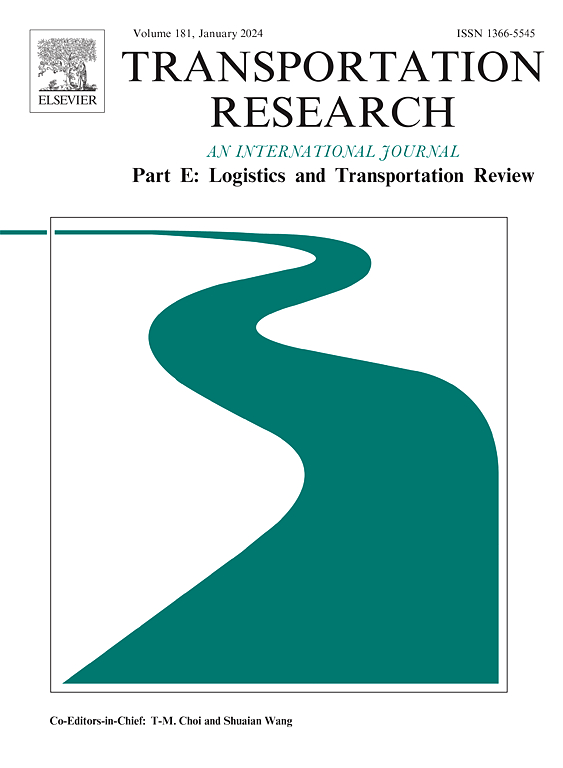Port carbon emission estimation: Principles, practices, and machine learning applications
IF 8.3
1区 工程技术
Q1 ECONOMICS
Transportation Research Part E-Logistics and Transportation Review
Pub Date : 2025-05-02
DOI:10.1016/j.tre.2025.104159
引用次数: 0
Abstract
Ports are central to global trade and transportation, playing a significant role in worldwide carbon emissions. Estimating carbon emissions from ports is crucial for identifying emission sources and devising strategies for their reduction. The procedure of port carbon emission estimation follows the logic of “estimation methods — data acquisition and preprocessing — application realization” and faces many challenges currently. First, this review explores the complex terrain of port carbon emission estimation, addressing both ship-side and shore-side emissions, which examines the principles and applications of these methods. Second, evaluates the role of machine learning (ML) technologies in enhancing data accuracy due to the low quality of raw acquisition data. Specifically, Generative Adversarial Networks (GAN) proves useful in repairing ship-side and port-side raw production data. Finally, to support port authorities and government decision-makers in carbon emission estimation realization, the development of effective and practical software applications is essential, which follows a logical sequence: “conceptual design — prototype design — improved design”. This review focuses on data-driven approaches for assessing port carbon emissions while acknowledging potential limitations, such as those associated with sensor-based estimation techniques. Future research should compensate for this shortcoming by refining sensor calibration techniques and integrating complementary data sources to enhance the accuracy and reliability of port carbon emissions estimates.
港口碳排放估算:原理、实践和机器学习应用
港口是全球贸易和运输的中心,在全球碳排放中发挥着重要作用。估计港口的碳排放量对于确定排放源和制定减少排放的战略至关重要。港口碳排放估算过程遵循“估算方法-数据采集与预处理-应用实现”的逻辑,目前面临诸多挑战。首先,本文探讨了港口碳排放估算的复杂地形,包括船侧和岸侧排放,并研究了这些方法的原理和应用。其次,由于原始采集数据质量较低,评估了机器学习(ML)技术在提高数据准确性方面的作用。具体而言,生成对抗网络(GAN)在修复船侧和港口侧原始生产数据方面被证明是有用的。最后,为了支持港口当局和政府决策者实现碳排放估算,开发有效实用的软件应用程序是必不可少的,其逻辑顺序是:“概念设计-原型设计-改进设计”。本综述侧重于评估港口碳排放的数据驱动方法,同时承认潜在的局限性,例如与基于传感器的估计技术相关的局限性。未来的研究应通过改进传感器校准技术和整合互补数据源来弥补这一不足,以提高港口碳排放估算的准确性和可靠性。
本文章由计算机程序翻译,如有差异,请以英文原文为准。
求助全文
约1分钟内获得全文
求助全文
来源期刊
CiteScore
16.20
自引率
16.00%
发文量
285
审稿时长
62 days
期刊介绍:
Transportation Research Part E: Logistics and Transportation Review is a reputable journal that publishes high-quality articles covering a wide range of topics in the field of logistics and transportation research. The journal welcomes submissions on various subjects, including transport economics, transport infrastructure and investment appraisal, evaluation of public policies related to transportation, empirical and analytical studies of logistics management practices and performance, logistics and operations models, and logistics and supply chain management.
Part E aims to provide informative and well-researched articles that contribute to the understanding and advancement of the field. The content of the journal is complementary to other prestigious journals in transportation research, such as Transportation Research Part A: Policy and Practice, Part B: Methodological, Part C: Emerging Technologies, Part D: Transport and Environment, and Part F: Traffic Psychology and Behaviour. Together, these journals form a comprehensive and cohesive reference for current research in transportation science.

 求助内容:
求助内容: 应助结果提醒方式:
应助结果提醒方式:


